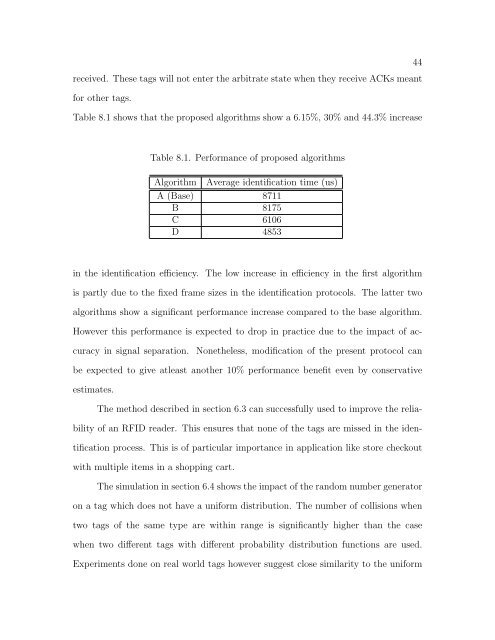utilizing physical layer information to improve rfid tag
utilizing physical layer information to improve rfid tag
utilizing physical layer information to improve rfid tag
You also want an ePaper? Increase the reach of your titles
YUMPU automatically turns print PDFs into web optimized ePapers that Google loves.
eceived. These <strong>tag</strong>s will not enter the arbitrate state when they receive ACKs meant<br />
for other <strong>tag</strong>s.<br />
Table 8.1 shows that the proposed algorithms show a 6.15%, 30% and 44.3% increase<br />
Table 8.1. Performance of proposed algorithms<br />
Algorithm Average identification time (us)<br />
A (Base) 8711<br />
B 8175<br />
C 6106<br />
D 4853<br />
in the identification efficiency. The low increase in efficiency in the first algorithm<br />
is partly due <strong>to</strong> the fixed frame sizes in the identification pro<strong>to</strong>cols. The latter two<br />
algorithms show a significant performance increase compared <strong>to</strong> the base algorithm.<br />
However this performance is expected <strong>to</strong> drop in practice due <strong>to</strong> the impact of ac-<br />
curacy in signal separation. Nonetheless, modification of the present pro<strong>to</strong>col can<br />
be expected <strong>to</strong> give atleast another 10% performance benefit even by conservative<br />
estimates.<br />
The method described in section 6.3 can successfully used <strong>to</strong> <strong>improve</strong> the relia-<br />
bility of an RFID reader. This ensures that none of the <strong>tag</strong>s are missed in the iden-<br />
tification process. This is of particular importance in application like s<strong>to</strong>re checkout<br />
with multiple items in a shopping cart.<br />
The simulation in section 6.4 shows the impact of the random number genera<strong>to</strong>r<br />
on a <strong>tag</strong> which does not have a uniform distribution. The number of collisions when<br />
two <strong>tag</strong>s of the same type are within range is significantly higher than the case<br />
when two different <strong>tag</strong>s with different probability distribution functions are used.<br />
Experiments done on real world <strong>tag</strong>s however suggest close similarity <strong>to</strong> the uniform<br />
44
















